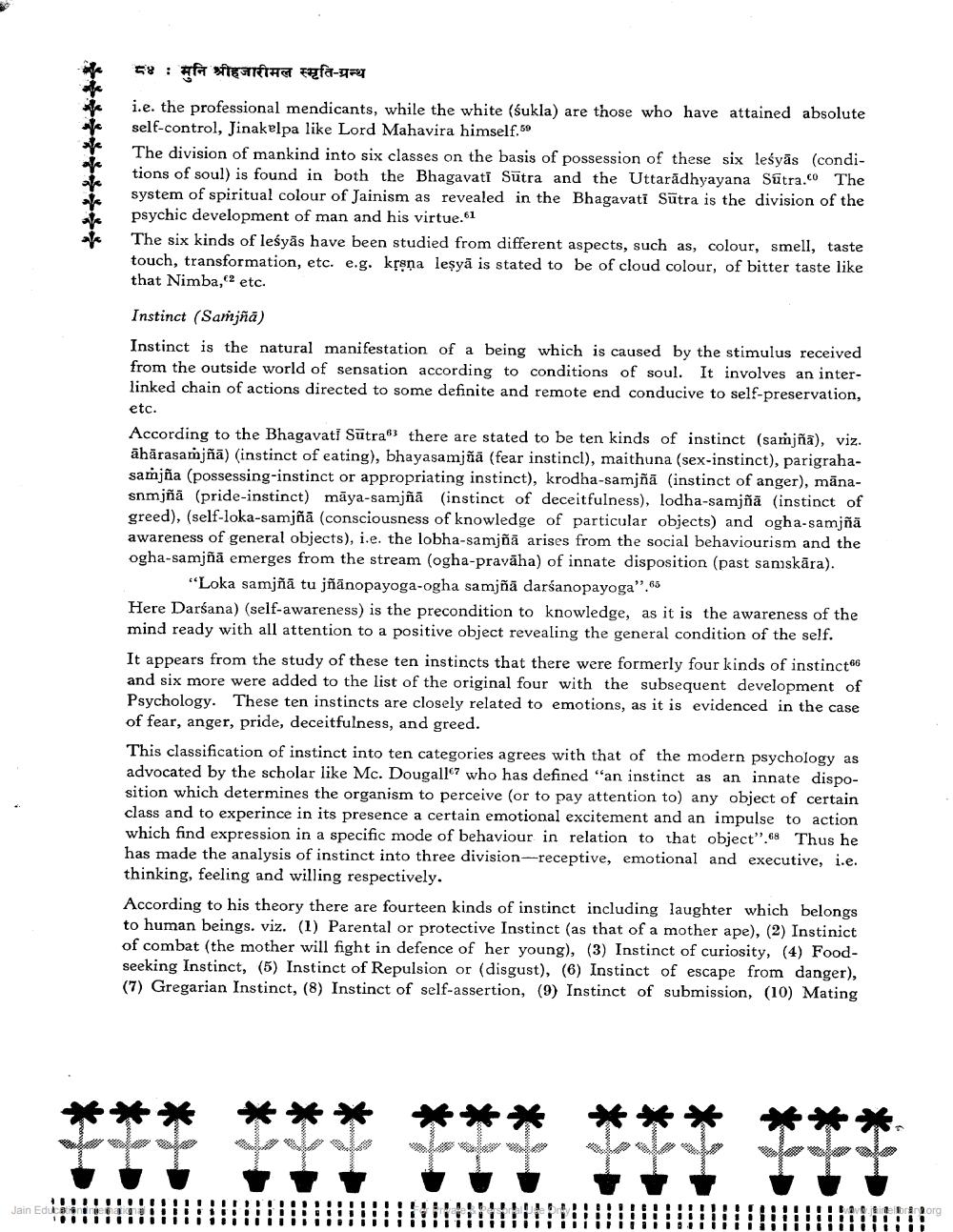________________
८४ : मुनि श्रीहजारीमल स्मृति-ग्रन्थ
i.e. the professional mendicants, while the white (sukla) are those who have attained absolute self-control, Jinakelpa like Lord Mahavira himself.60 The division of mankind into six classes on the basis of possession of these six leśyās (conditions of soul) is found in both the Bhagavati Sutra and the Uttarădhyayana Sutra.co The system of spiritual colour of Jainism as revealed in the Bhagavati Sūtra is the division of the psychic development of man and his virtue.61 The six kinds of leśyās have been studied from different aspects, such as, colour, smell, taste touch, transformation, etc. e.g. krsna leşyā is stated to be of cloud colour, of bitter taste like that Nimba,2 etc.
Instinct (Saṁjña) Instinct is the natural manifestation of a being which is caused by the stimulus received from the outside world of sensation according to conditions of soul. It involves an interlinked chain of actions directed to some definite and remote end conducive to self-preservation, etc. According to the Bhagavati Sütra there are stated to be ten kinds of instinct (samiña). viz. āhārasamjñā) (instinct of eating), bhayasamjñā (fear instincl), maithuna (sex-instinct), parigrahasamjña (possessing-instinct or appropriating instinct), krodha-samjñā instinct of anger), mānasnmjñā (pride instinct) māya-samjñā (instinct of deceitfulness), lodha-samjñā (instinct of greed), (self-loka-samjñā (consciousness of knowledge of particular objects) and ogha-samjñā awareness of general objects), i.e. the lobha-samjñā arises from the social behaviourism and the ogha-samjñā emerges from the stream (ogha-pravāha) of innate disposition (past samskāra).
"Loka samjñā tu jñānopayoga-ogha samjñā darśanopayoga". 65 Here Darśana) (self-awareness) is the precondition to knowledge, as it is the awareness of the mind ready with all attention to a positive object revealing the general condition of the self. It appears from the study of these ten instincts that there were formerly four kinds of instinct 66 and six more were added to the list of the original four with the subsequent development of Psychology. These ten instincts are closely related to emotions, as it is evidenced in the case of fear, anger, pride, deceitfulness, and greed. This classification of instinct into ten categories agrees with that of the modern psychology as advocated by the scholar like Mc. Dougall who has defined "an instinct as an innate disposition which determines the organism to perceive (or to pay attention to any object of certain class and to experince in its presence a certain emotional excitement and an impulse to action which find expression in a specific mode of behaviour in relation to that object".68 Thus he has made the analysis of instinct into three division-receptive, emotional and executive, i.e. thinking, feeling and willing respectively. According to his theory there are fourteen kinds of instinct including laughter which belongs to human beings. viz. (1) Parental or protective Instinct (as that of a mother ape), (2) Instinict of combat (the mother will fight in defence of her young), (3) Instinct of curiosity, (4) Foodseeking Instinct, (5) Instinct of Repulsion or (disgust), (6) Instinct of escape from danger), (7) Gregarian Instinct, (8) Instinct of self-assertion, (9) Instinct of submission, (10) Mating
*
*
* to
* * tak
*
*
* e
*
*** * part
*****
of
IIIIIIIIIIIIIIIIIIIIIIIIIIIIIIIIIIIIIIIIIIIIIIIIIIIIIIIIIIIIIII intelorg Main Edi Band III I IIIIIIIII
IIIIIiiiiiiiiiiiiiiiiiiii IIIIIIIIIIIIIIIIIIIIIIIII!iiiiiiiiiiiiiiiIIIIIIIIIIIIIIIIiiiiiiiiiiiiiii




